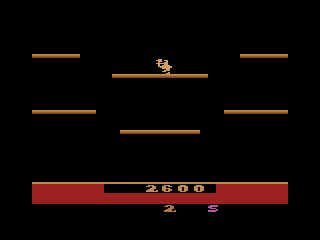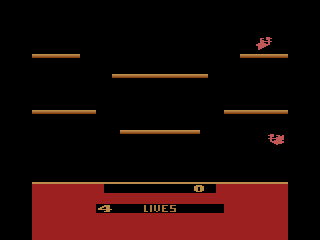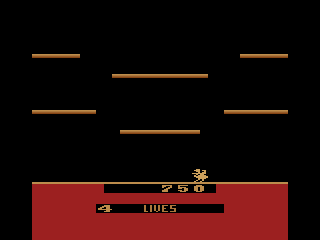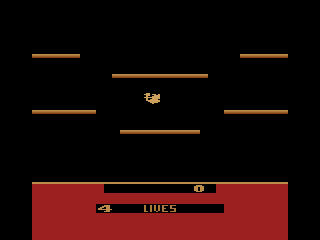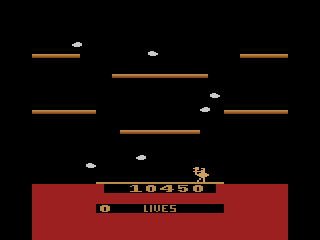|
|
Joust
|
Name:
|
Joust |
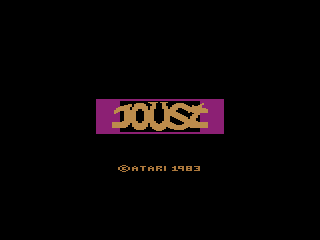 |
| Company: | Atari | |
|
Model #:
|
CX-2691 | |
|
Programmers:
|
Mike Feinstein & Kevin Osborn (GCC) | |
| Year: | 1983 | |
|
Released?
|
Yes
|
|
|
Notes:
|
Port of the 1982 Williams Coin-Op |
Jousting and ostriches... They go together like peanut butter and jelly. Well maybe not, but they do make for one awesome game. Who ever thought of knights jousting on the backs of ostriches and buzzards needs some serious help. However Joust is just one example of the innovative and highly original games that were commonplace in the 80's (remember when every game wasn't a doom clone?). Joust was so popular that it even spawned a sequel, but sadly Joust 2 was never released for any home system.
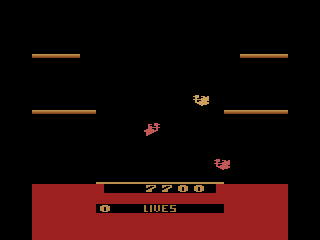
As the name implies, this game involves jousting. Actually it's not so much jousting as it is belly flopping on top of the enemy (going lance to lance only results in the enemy and player bouncing back). The trick to unseating the enemy is really to hit him above the lance with the bottom of your ostrich. While this may sound difficult (and it kinda is), it quickly becomes second nature.
When an enemy is hit he'll drop an egg which will hatch after a few seconds (assuming it doesn't land in the lava). When an egg hatches it automatically gets upgraded to the next class of enemy (Bounders hatch into Hunters, and Hunters hatch into Shadow Lords), so be quick about picking them up. Unlike in the 2600 version, the eggs in this version don't fly around the screen and generally only bounce a few inches before coming to a stop.
Starting on the third wave you'll notice that the ledges above the lava at the bottom of the screen disappear. Once this protective layer is gone, flying too close to the lava will result in your bird being grabbed by the Lava Troll. The Laval Troll gets his kicks by pulling your bird (or the enemy) down into the lava, so make sure you fly a healthy distance above. If you happen to get caught by the Lava Troll, quickly press the flap button to break free. If you're good enough you can use the Lava Troll to get rid of some of those pesky buzzards by luring them down towards the lava. However this trick is a risky proposition at best, as it often results in you going under as well.
A programmer's job is never easy, and taking a game with as moving objects as Joust and porting to the 2600 is a tall order. To successfully produce that many moving sprites GCC had to do some cleaver programming tricks. One trick they used was drawing the player for only a few clock cycles, then quickly erasing the player and drawing the enemies and eggs for the rest of the cycles. By doing this they were able to get the many more sprites on the screen than would normally be possible.
One side effect of this trick is that everything in the game appears to flicker because it's quickly appearing and disappearing. This can be shown by taking a screenshot where you will either see either the player or the enemy, but not both. Another trick GCC employed to get the most out of the 8K they were limited to was to reuse the player's flight routine for the eggs. Normally the eggs bounce a bit and stop, but in the 2600 version they appear to float around the screen and never come to a stop.
While Joust is a great one player game, it's considered to be one of the best for two player simultaneous play. Depending on what kind of mood you're in, you can either team up with a friend or try and destroy them. This kind of two player flexibility combine with a great gameplay concept makes Joust one of the best games of all time. Despite these annoying flaws, the 2600 version of Joust holds up quite well considering how limiting the 2600 hardware was. It may not be the prettiest version of Joust to look at, but it gets the job done.
| Version | Cart Text | Description |
| 7/5/83 | Joust 186-07 | Flickers badly. Some color differences. |
| 8/9/83 | Joust 222 | Very minor code differences |
| ?????? | Joust PAL | Final PAL version. |

